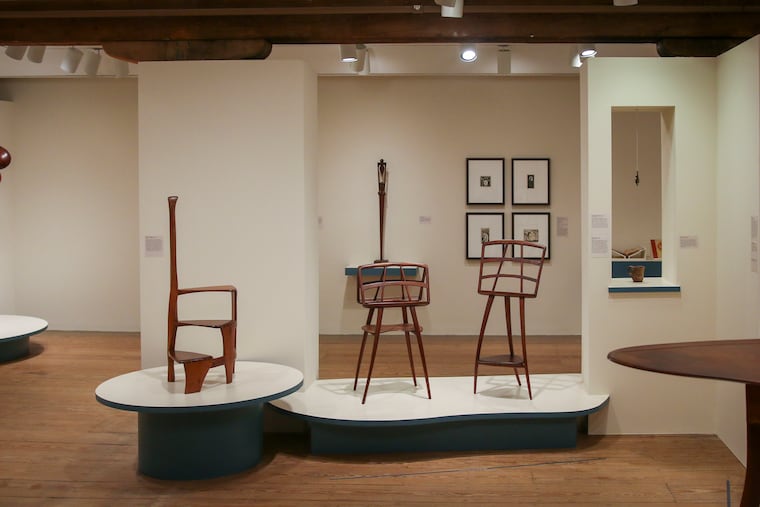Philadelphia artist Wharton Esherick’s modernist wood furniture is part of new Brandywine show
“The Crafted World of Wharton Esherick” is the largest exhibit of items drawn from the artist’s Paoli home and studio, ever.

In the late 1930s, the Philadelphia-born Wharton Esherick (1887-1970), a struggling artist, bought two barrels of hammer handles at a local auction. For years, the painter, who’d trained at what became known as University of the Arts and at Pennsylvania Academy of the Fine Arts, had scarcely sold any of his canvases. Living on a homestead near Paoli with a wife and three children to support, Esherick had lately turned to woodworking for income, hewing sculptural and utilitarian forms.
With the barrel’s contents — variously sized ash and hickory shafts — Esherick fashioned three dozen chairs, each costing a mere $1.76 to make. He bartered the chairs to the Hedgerow Theatre Company in Media in exchange for his daughter’s acting classes. Soon Esherick, too, had an audience, as wealthy theatergoers encountered the chairs and subsequently commissioned his innovative furniture for their homes.
One of Esherick’s clients was Justice William Curtis Bok. According to Wharton Esherick: The Journey of a Creative Mind, a biography written by Esherick’s son-in-law, Mansfield “Bob” Bascom, Bok reflected on the woodworker’s increasingly ambitious and expensive creations, which now included bespoke fireplaces, dining tables, and desks. “Never in my wildest dreams did I think it would be so beautiful — or cost so much,” he said.
In addition to transforming clients’ living spaces, Esherick built himself a studio and workshop on the hill behind his farmhouse, furnishing the premises entirely with his handiwork — from sofas and beds to wastebaskets and door latches — making it impossible to tell where Esherick’s private life ended and his art began.
Since 1972, the site has operated as the Wharton Esherick Museum (WEM).
However, from now until Jan. 19, visitors to the Brandywine Museum of Art in Chadds Ford can examine 70 examples of Esherick’s work — including one of his hammer chairs.
Organized in collaboration with the WEM, located a 40-minute drive from the Brandywine, The Crafted World of Wharton Esherick — which will also travel to Chazen Museum of Art in Madison, Wis., and the Taft Museum of Art in Cincinnati, Ohio — is the largest ever exhibit of items drawn from the artist’s home and studio.
It’s also the first time in more than 50 years that many of the exhibit’s items have traveled beyond Esherick’s studio and workshop, which has variously been dubbed “my autobiography in three dimensions” by the artist, and the “House of Wows,” by Bascom, for its ingenious and surprising functional artwork.
“We are bringing Esherick to a bigger audience,” said Emily Zilber, the exhibit’s curator and WEM’s director of curatorial affairs and strategic partnerships. Designed to introduce Esherick’s work to a new generation, as well as appeal to those who already know him as “The Dean of American Craftsmen,” the show is organized into thematic vignettes: Rural and Urban, Pattern Recognition, Bodies in Space, and The Way Things Grow.
The exhibit and accompanying catalog published by Rizzoli Electa spotlights Esherick’s command of multiple mediums — including paintings, woodcarvings, woodblock prints, and sculpture — all of which gesture toward Esherick’s lifelong interest and engagement with other arts — such as dance, literature, and music.
Viewers will discover pencil sketches of dancers, woodblock print illustrations for Walt Whitman’s poem “Song of the Broad-Axe,” and a delicate double music stand, made of cherry and walnut, whereby two musicians may face each other as they play.
Zilber wants visitors to the exhibit to walk away, “more connected” to Esherick’s vision as well as to “how it changed and evolved” over the artist’s prolific 60-plus year career.
“He lived from horse and buggy to jet planes … from Belle Epoch, Arts and Crafts movement through cubism [and] abstract expressionism,” Bascom notes in his book’s introduction.
As commercially manufactured items increasingly replaced handcrafted works, Esherick steadfastly resisted mass production. In his essay, “I Build a Building, or He Helps Me Build a Building,” Esherick writes: “Tenderness in a tough hand … Fingers close together but the whole hand loose and slightly arched.” The remarks hearken the grace and strength of Esherick’s work, which has eluded notoriety, despite being featured at the 1939-1940 New York World’s Fair and exhibited at the Pennsylvania Academy of the Fine Arts, the Whitney Museum, the Museum of Modern Art, the Tate, and at the Museum of Contemporary Crafts for a 1958-59 retrospective of his work in New York.
Following his death in 1970, Wharton Esherick won a gold medal for craftsmanship from the American Institute of Architects. Yet many hear his name and wonder if he’s affiliated with Penn’s business school, WEM’s executive director, Julie Siglin, said.
Perhaps graceful strength was what drove Esherick to push aside paintbrushes and pick up new utensils, including, serendipitously, two barrels of hammer shafts.
In a full circle moment, in 2020 one of the $1.76 hammer chairs went up for auction, selling for almost $9,000. Irrespective of its commercial value, the furniture’s qualities persist, which its maker described as “comfortable to sit in, good to look at, and [though currently on exhibit for viewing only] strong enough for a man to lean back in.”
“The Crafted Wold of Wharton Esherick” runs through Jan. 19. Brandywine Museum of Art, 1 Hoffmans Mill Rd., Chadds Ford, Pa., brandywine.org